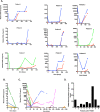Monitoring of epidermal growth factor receptor tyrosine kinase inhibitor-sensitizing and resistance mutations in the plasma DNA of patients with advanced non-small cell lung cancer during treatment with erlotinib
- PMID: 25103305
- PMCID: PMC4303984
- DOI: 10.1002/cncr.28964
Monitoring of epidermal growth factor receptor tyrosine kinase inhibitor-sensitizing and resistance mutations in the plasma DNA of patients with advanced non-small cell lung cancer during treatment with erlotinib
Abstract
Background: The feasibility of monitoring epidermal growth factor receptor (EGFR) mutations in plasma DNA from patients with advanced non-small cell lung cancer (NSCLC) during treatment with erlotinib and its relation to disease progression was investigated.
Methods: The amount of EGFR-mutant DNA was tested in plasma DNA from patients with advanced NSCLC with allele-specific polymerase chain reaction assays. Blood samples from 23 patients with adenocarcinoma of NSCLC that carried tyrosine kinase inhibitor-sensitizing EGFR mutations were taken immediately before treatment with erlotinib. Additional blood samples were taken at timed intervals until erlotinib treatment was withdrawn.
Results: The amount of plasma DNA with sensitizing EGFR mutations was found to be reduced after the first cycle of erlotinib treatment in 22 of 23 patients (96%). No patients presented with the resistant T790M mutation in the pretreatment sample, but at the time of disease progression the mutation was detected in plasma from 9 patients (39%). The quantitative data from the current study demonstrated that when a T790M mutation emerged in the blood it was accompanied by an increase in the original sensitizing EGFR mutation. When T790M was detected, it was found to be present in all subsequent blood samples from that patient. Most interestingly, the results of the current study demonstrated that monitoring the EGFR mutations in the blood allows for the detection of the T790M mutation up to 344 days before disease progression is clinically evident (range, 15-344 days).
Conclusions: The results of the current study demonstrated that serial monitoring of EGFR mutations in plasma DNA is feasible and may allow for the early detection of resistance mutations. These results warrant further studies to explore the clinical usefulness of such analysis.
Trial registration: ClinicalTrials.gov NCT00815971.
Keywords: epidermal growth factor receptor (EGFR) mutations; erlotinib; lung cancer; plasma DNA; resistance.
© 2014 American Cancer Society.
Figures

Comment in
-
Monitoring cancer through the blood.Cancer. 2014 Dec 15;120(24):3859-61. doi: 10.1002/cncr.28967. Epub 2014 Aug 7. Cancer. 2014. PMID: 25103496 Free PMC article. No abstract available.
References
-
- Lynch TJ, Bell DW, Sordella R. Activating mutations in the epidermal growth factor receptor underlying responsiveness of non–small-cell lung cancer to gefitinib. N Engl J Med. 2004;350:2129–2139. - PubMed
-
- Paez JG, Janne PA, Lee JC. EGFR mutations in lung cancer: correlation with clinical response to gefitinib therapy. Science. 2004;304:1497–1500. - PubMed
-
- Kobayashi S, Boggon TJ, Dayaram T. EGFR mutation and resistance of non–small-cell lung cancer to gefitinib. N Engl J Med. 2005;352:786–792. - PubMed
Publication types
MeSH terms
Substances
Associated data
LinkOut - more resources
Full Text Sources
Other Literature Sources
Medical
Research Materials
Miscellaneous

